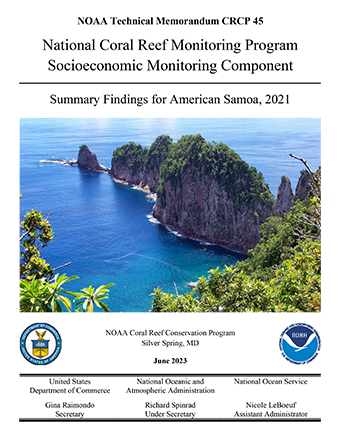
The Socioeconomic Component of the National Coral Reef Monitoring Program (NCRMP) gathers and monitors a collection of socioeconomic data in seven U.S. coral jurisdictions. The team continued its second monitoring cycle with data collection in American Samoa in 2021, and recently released their report of summary findings along with two new infographics. The report outlines current human dimensions information relevant to coral reef resources in American Samoa, as well as trends between the first (2014) and second monitoring cycles. The first infographic focuses solely on the 2021 findings, while the second focuses on trends, and both infographics are also available in Samoan. Survey results are representative of American Samoa residents (further stratified by Rural, Semi-rural, and Urban, as well as the Village of Aua and the Manuʻa Islands).
Household surveys conducted in May to September of 2021 revealed that American Samoa residents were familiar with a variety of threats to coral reefs and generally supported a range of potential marine management policies and regulations, such as incorporating traditional Samoan practices into coral reef management, improving law enforcement, and implementing stricter control of pollution sources to preserve water quality. Residents also supported the establishment of Marine Protected Areas and generally believed they have led to a range of improved benefits for coral reefs and coastal communities. There was a general consensus that American Samoa’s coral reefs are important to culture, coastal protection, the local economy, and food for coastal communities. Residents believed that the overall marine ecosystem in American Samoa had become worse or not changed over the past ten years, but most believed that resource conditions may improve in the future. In 2021, the conditions of ocean water quality and amount of live coral were particular concerns. Additionally, most resident households consumed seafood on a weekly basis, and nearly all residents ate local seafood from coral reefs at least once a month. Surveys also showed that swimming/wading, beach recreation, and waterside/beach camping were primary activities for American Samoa residents in both 2014 and 2021, but frequency of participation in all activities declined in 2021.

In general, the results indicate that American Samoa residents have important human connections to coral reefs and rely on these ecosystems for a variety of cultural and socioeconomic benefits. As each monitoring cycle takes between five and seven years to complete, American Samoa residents are on schedule for surveying again in 2028.
Visit the publication page to access and download the full publication and infographics.
The NCRMP Socioeconomic team is currently busy drafting products for Puerto Rico, analyzing data from Guam, and planning data collection for the Commonwealth of Northern Mariana Islands.
